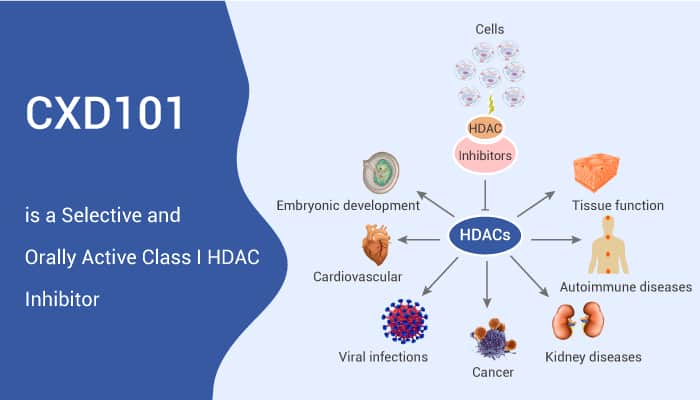Aberrant expression of classical HDACs associates with a variety of malignancies, including solid and hematological tumors. HDACs have also been found broadly dysregulated in multiple myeloma (MM). In particular, the mechanisms that HDACs regulate tumorigenesis are quite diverse. HDACs induce a range of cellular and molecular effects through the hyperacetylation of histone and nonhistone substrates. Especially, HDACs repress tumor suppressor gene expression or regulate the oncogenic cell-signaling pathway via modification of key molecules. Certain HDACs function as the catalytic subunits of large corepressor complexes and drive tumorigenesis. For example, the aberrant recruitment of HDAC1, 2, or 3 by oncogenic fusion proteins AML1-ETO and PML-RAR contributes to the pathogenesis of acute myeloid leukemia (AML).
CXD101 is a potent class 1 selective HDAC inhibitor with IC50s of 63 nM, 570 nM, 550 nM for HDAC1, HDAC2, and HDAC3, respectively. However, CXD101 has no activity against class 2 HDAC. Moreover, CXD101 demonstrates potent antiproliferative activity against various cancer cells in vitro. Researchers have tested CXD101 in colon, lung, non‐Hodgkin lymphoma, and myeloma cell lines with IC50s of 0.2-15 μM.

CXD101 (50 mg/kg) substantially reduces tumor size in murine xenograft lung (A549a) and colon (HT29) models. Tumor reduction associates with increased histone acetylation and decreased HDAC enzyme activity. Furthermore, CXD101 has a pharmacokinetic (PK) and PD profile in mice and canines with relatively reduced interindividual variations in these parameters. Peak plasma concentrations (Tmax) reach 1 to 4 hours after dosing and the CXD101 half‐life is 5 to 12 hours.
To summarise, CXD101 is a selective and orally active class I HDAC inhibitor for advanced cancer.